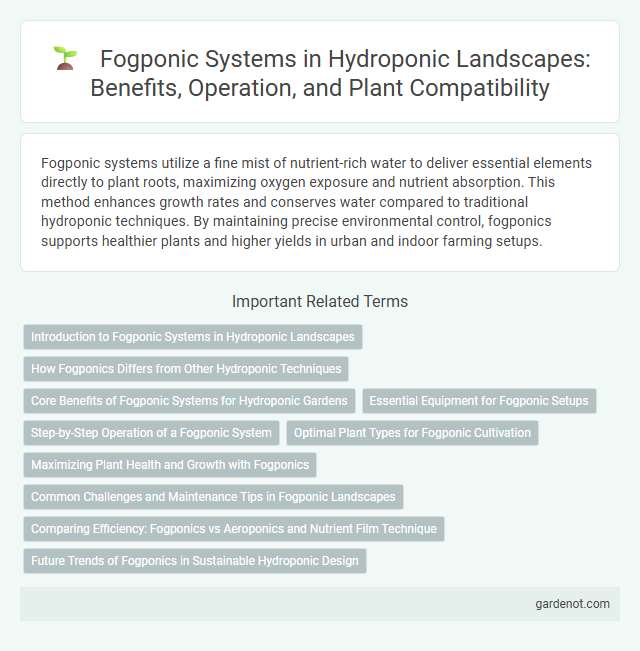Fogponic systems utilize a fine mist of nutrient-rich water to deliver essential elements directly to plant roots, maximizing oxygen exposure and nutrient absorption. This method enhances growth rates and conserves water compared to traditional hydroponic techniques. By maintaining precise environmental control, fogponics supports healthier plants and higher yields in urban and indoor farming setups.
Introduction to Fogponic Systems in Hydroponic Landscapes
Fogponic systems in hydroponic landscapes utilize a fine mist of nutrient-rich water to deliver oxygen and nutrients directly to plant roots, enhancing growth efficiency. This technology maximizes root exposure to oxygen, promoting faster nutrient uptake compared to traditional hydroponic methods. Fogponic systems reduce water usage significantly while improving overall plant health and yield in controlled environment agriculture.
How Fogponics Differs from Other Hydroponic Techniques
Fogponics uses ultrasonic technology to create a fine mist of nutrient-rich water droplets, allowing plant roots to absorb nutrients and oxygen more efficiently than traditional hydroponic methods like nutrient film technique or ebb and flow systems. The ultra-fine fog particles increase root exposure to oxygen, promoting faster growth and healthier root systems compared to water or nutrient solution immersion in other systems. This method reduces water and nutrient use while enhancing aeration, making it a highly efficient approach within hydroponic landscaping.
Core Benefits of Fogponic Systems for Hydroponic Gardens
Fogponic systems enhance hydroponic gardens by delivering nutrient-rich mist directly to plant roots, promoting faster growth and higher yields compared to traditional methods. The ultra-fine fog increases oxygen availability at the root zone, improving nutrient absorption and reducing water usage by up to 90%. This efficient system minimizes root diseases and allows precise control over nutrient delivery, optimizing plant health and productivity in hydroponic landscapes.
Essential Equipment for Fogponic Setups
A Fogponic system requires a high-frequency ultrasonic fogger to generate nutrient-rich mist, which delivers precise moisture and oxygen to plant roots. An enclosed reservoir with a water circulation pump maintains nutrient solution stability and prevents stagnation. Complementary equipment includes climate control devices such as humidifiers and fans to regulate temperature and humidity, ensuring optimal growth conditions in the hydroponic landscape.
Step-by-Step Operation of a Fogponic System
A Fogponic system operates by atomizing nutrient-rich water into ultrafine mist particles using ultrasonic foggers, which deliver moisture and nutrients directly to plant roots suspended in air. The process begins with filling the reservoir with a balanced hydroponic nutrient solution, followed by activating the foggers that create a dense fog within the root chamber, ensuring optimal oxygenation and nutrient absorption. Continuous circulation and temperature control maintain ideal conditions, promoting faster growth and higher yields in fogponically grown plants.
Optimal Plant Types for Fogponic Cultivation
Fogponic systems are ideal for growing delicate and fast-growing plants such as leafy greens, herbs like basil and mint, and small fruits like strawberries due to their precise nutrient mist delivery and high oxygen availability. Orchids and other epiphytic plants also thrive in fogponic setups because the fine mist closely mimics their natural humid environment. Optimal plant types for fogponic cultivation generally include species with high oxygen requirements and sensitive root systems that benefit from the system's improved nutrient absorption efficiency.
Maximizing Plant Health and Growth with Fogponics
Fogponics enhances plant health by delivering nutrient-rich mist directly to roots, ensuring optimal oxygen absorption and nutrient uptake. This system reduces water usage by up to 90% compared to traditional hydroponics, promoting sustainable growth. High humidity levels and fine droplet size improve root respiration and accelerate plant development in controlled environments.
Common Challenges and Maintenance Tips in Fogponic Landscapes
Fogponic systems often face challenges such as nozzle clogging, inconsistent fog distribution, and root diseases caused by excess moisture. Regular cleaning of nozzles, maintaining optimal water quality by using filtered or distilled water, and ensuring proper ventilation can prevent these issues. Implementing routine inspection schedules and using antimicrobial additives help sustain healthy root environments in fogponic landscapes.
Comparing Efficiency: Fogponics vs Aeroponics and Nutrient Film Technique
Fogponic systems deliver nutrients via ultra-fine mist, enabling superior oxygenation and faster nutrient absorption compared to Aeroponics, which uses larger droplets, and the Nutrient Film Technique (NFT) that relies on a thin water film. Studies show fogponics can increase root respiration rates by up to 40%, enhancing growth efficiency and yield quality. While NFT is simpler, fogponics optimizes water and nutrient use, reducing consumption by up to 70% compared to traditional hydroponic methods.
Future Trends of Fogponics in Sustainable Hydroponic Design
Fogponic systems utilize nutrient-rich mist to deliver oxygen and nutrients directly to plant roots, maximizing growth efficiency while minimizing water consumption. Future trends in fogponics emphasize integration with AI-driven monitoring systems to optimize nutrient delivery and environmental conditions, promoting sustainable urban agriculture. Advances in nano-mist technology and renewable energy-powered foggers are poised to revolutionize eco-friendly hydroponic landscapes by reducing resource use and enhancing crop yield.
Fogponic system Infographic

 gardenot.com
gardenot.com